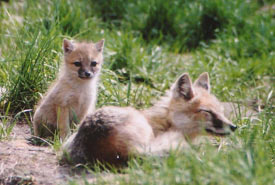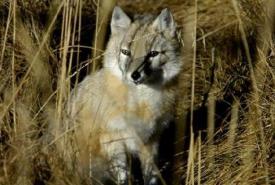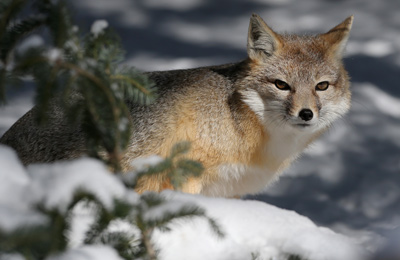On a quest for the alluring swift fox

Swift fox cub and its mum (Photo by Catriona Matheson, Cochrane Ecological Institute)
My unsuccessful search for the elusive swift fox has spanned nearly a decade.
It was 2008, the winter semester of my first year at Lakeland College in Vermilion, Alberta, when I first learned about the history of swift foxes in Canada. The smallest canine in North America, the swift fox ranged from the east side of the Rocky Mountains all the way into southwest Manitoba, and from the U.S. border to as far north as the 53rd parallel. Because of the arrival of European settlers across the prairies and the large-scale programs that followed to control predators, the last sighting of a wild swift fox in Canada was in 1938 near Manyberries, Alberta. In 1978, the species was officially designated as extirpated, meaning that it could no longer be found in Canada, but was still found throughout other parts of its native range.
Reintroduction programs have helped re-establish populations in Alberta and Saskatchewan, with the release of 805 swift foxes between 1983 and 1997. Despite conservation efforts, the species remains listed as threatened — in 2009, the Canadian population estimate was 647.

Swift fox (Photo by Karol Dabbs)
Swift fox are about the size of a housecat standing on its hind legs, and it tips the scale between 1.6 to 3 kilograms. It has a thick grey “stripe” down its back, extending to its black-tipped tail. Its underside is white to buff in colour. On either side of its muzzle are black patches.
What an alluring animal to try to catch a glimpse of.
I have been fortunate enough to observe many species at risk in their natural habitat throughout my career. I have seen burrowing owls sitting out on the mounds in front of their burrows, been dive-bombed by a pair of ferruginous hawks after getting too close to their nest, nearly stepped on a well-camouflaged short-horned lizard...The list goes on and includes species like piping plover, Great Plains toad and little brown bat, but one of the few species that has evaded me over the years has been swift fox.
I have seen coyote pups in the field and excitedly mistaken them for swift fox, as their colouration and black-tipped tail are quite similar. What helped me determine that they were in fact coyote pups was the absence of the black patches on either side of the muzzle. A closer inspection of the den site also helped me to deduce that they were not swift fox. In addition to the den being smaller than that of coyotes, swift fox den entrances have a characteristic keyhole shape, which this den was lacking.

Swift fox, SK (Photo by Mike Dembeck)
Despite living near and working throughout the swift fox’s range in Alberta for four years, I never managed to get lucky enough to see one. My wife’s field work for her master’s of science on greater sage grouse had us spending countless weekends trekking across the some of the largest remaining blocks of native prairie in southeast Alberta and driving hundreds of kilometres down gravel roads. Of course, on a day that I wasn’t with her, a swift fox crossed the road right in front of her. I wouldn’t have been as upset if it hadn’t been on a road that we drove down multiples times the day or two before. There it was trotting across the road in broad daylight; something you don’t see that often.
My Nature Conservancy of Canada (NCC) colleagues can attest that I take my quest for swift foxes very seriously. On my way to conduct field work recently in southwest Saskatchewan, I brought the truck to a grinding halt a few kilometres east of NCC’s Old Man on His Back Prairie and Heritage Conservation Area when I spotted a small dog-like animal standing about 100 metres off the road in a field. I threw the truck in park and began furiously digging through my belongings to find my binoculars. I was quite dismayed to discover that it was, in fact, your everyday red fox.
These are not the first disappointments I've had in my search for the swift fox, and I am sure they won't be the last, but I remain optimistic. I’ll continue to find every excuse I can to wander the prairies of southwest Saskatchewan for the slightest chance of glimpsing a swift fox in hopes of hitting my personal species at risk jackpot.
I guess it’s probably for the best though since, after I cross swift fox off my species at risk list, I’ll have to focus my efforts on the speedy and uncommon eastern yellow-bellied racer. Wish me luck!
The swift fox is one of nine species featured in NCC’s gift giving campaign: Gifts of Canadian Nature. To learn more and to give the gift of conservation this holiday season, click here.


